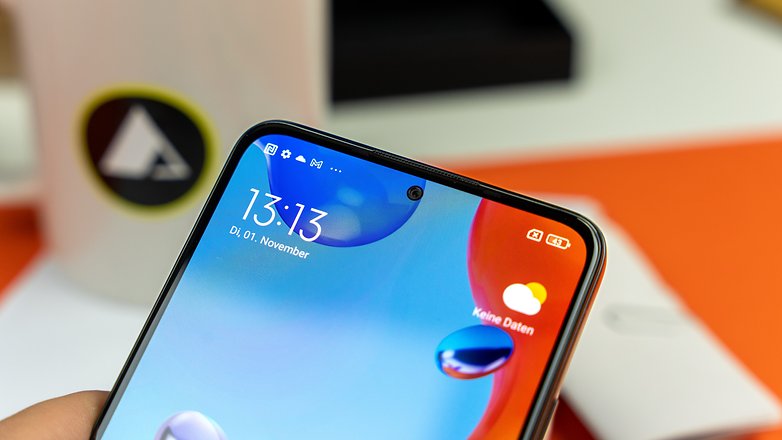Redmi Note 11 Pro review: Just shy of perfection


What do you think of how much a smartphone should cost when it comes with a 108 MP camera, 67-watt Quick Charging, a 6.67-inch AMOLED display with a 120 Hertz refresh rate, and a large battery? With the Redmi Note 11 Pro, you will pay just less than $300 for these specifications. I discovered in this NextPit review what you will have to live without at such a price point and whether it automatically gets elevated to the hallowed ranks of a good smartphone!
Good
- Great AMOLED display with thin bezels
- Solid performance of the MediaTek SoC
- Main camera delivers high-quality images
- Long battery life with fast quick-charging
Bad
- Insufficient updates in the long run
- No 5G support
- Ultra-wide angle camera is not very convincing
- Only IP53 certification
- No wireless charging

The Xiaomi Redmi Note 11 Pro in a nutshell
The Redmi Note 11 Pro not only convinces based on the hardware specifications, but also in everyday use. Xiaomi's mid-range flagship offers a lot of features, a modern design, good performance, and a surprisingly high-quality build. So, if you can still live without 5G connectivity in 2022, you can more or less pick one up without any hesitation. The only thing that works against it would be a rather lame software support time frame compared to some of the other alternatives in the market. Oh hello there, Samsung!
If you want to get the Note 11 Pro, you will have to budget approximately $300 for the base model in October 2022. The manufacturer tends to lower the price as time progresses, so if you want to save some money, perhaps you can wait a little bit longer.
Design & Display
The Redmi Note 11 Pro features a 6.67-inch AMOLED display that shines with a refresh rate of 120 hertz. The brightness of up to 1,200 nits is also outstanding for this price range. Thanks to the thin bezels, the Note 11 Pro is a slim smartphone that measures 164.19 x 76.1 x 8.12 millimeters and tips the scales at 202 grams. At the same time, it offers IP53 protection against water and dust.

What I liked:
- Fluid and bright AMOLED display.
- High-quality workmanship
- Crisp vibration motor.
What I disliked:
- Only comes with IP53 certification.
- Speaker is covered when gaming horizontally.
Apart from everything that is a matter of preference when it comes to smartphones, there is hardly anything at all to criticize about the design of the Redmi Note 11 Pro. The smartphone's construction is very solid, the build quality without any glaring gaps cannot be commended enough, and Xiaomi also paid attention to details like the vibration motor and the stereo speakers. While the former is nice and precise and crisp, the latter can quickly get obscured when gaming as you hold it horizontally.

Just like the Redmi Note 11, Xiaomi convinces with its outstanding displays in this price range. Content is displayed nicely on the large and sharp on the 6.67-inch screen at Full HD+ resolution in the Pro model. Thanks to the refresh rate of 120 hertz and a high sampling rate of 360 hertz, the display is also very responsive and cuts a good figure, especially in mobile games.
The brightness level of up to 1,200 nits at maximum brightness is also high enough that you can even read dark screen elements in the sunshine. The Note 11 Pro also has strikingly thin bezels for a smartphone in this price range. The chin is a bit thicker, but that is hardly annoying in everyday use.

However, I have to criticize the Redmi Note 11 Pro's low resistance against water and dust. A IP53 certification is sufficient for making calls in the rain, but the smartphone should not fall into water. To end on a positive note: Xiaomi's fingerprint scanner located on the power button is not only well positioned, it also works quickly and reliably.
Software & updates: Redmi's weak point
The Redmi Note 11 Pro ships with Android 11 right out of the box, and thus, it is a now two-year-old version of Google's operating system. Xiaomi's update promise for its Redmi series includes two major Android updates and three years of security updates from the launch. Xiaomi expands the feature set with its MIUI 13 skin.
What I liked:
- MIUI 13 brings a lot of features.
What I disliked:
- Disappointing lack of software updates.
- A lot of bloatware and annoying ads in the operating system.
As a smartphone from a Xiaomi sub-brand, the Redmi Note 11 Pro uses the Android skin known as MIUI. However, version 13 is based on Android 11, and thus, is a two-year-old version of Google's OS. This does not cause any major problems in everyday use thanks to MIUI's high feature set - which you can read more about in our MIUI 13 review, but it does cause problems in the long run.

This is because Redmi smartphones only receive two new Android updates and three years of security updates from its release. So, although the Note 11 Pro could last the next three or even four years in terms of performance, the smartphone will already stop at Android 13 - which is released this year. Other manufacturers, such as Samsung, offer far more here, especially with its Galaxy A series.
Another annoying thing about Xiaomi: Not only is there a lot of bloatware in the operating system, there are also advertisements in some places. Fortunately, the preinstalled apps can be uninstalled and you can also disable ads in MIUI. More great tips for MIUI can be found here.
Performance: Solid performance without 5G
The Redmi Note 11 Pro is powered by a Helio G96 SoC, which is advertised as a gaming processor by MediaTek. Together with a Mali G57 GPU and up to 8 GB of LPDDR4X RAM, this results in satisfactory performance in everyday use. You will have to live without 5G, but the internal storage of up to 128 GB can be expanded via a microSD card.

What I liked:
- Solid performance in everyday use and mobile games.
- Expandable memory.
What I disliked:
- No 5G modem.
With a Helio G96, the Redmi Note 11 Pro is not the most powerful smartphone under $400. This is because with models like the Poco F4, you can get alternatives that are equipped with SoCs from the upper class for a slightly higher price. Apart from a higher performance capability to play mobile games at the highest graphics settings, you will also have to make do without a 5G modem. If you live in a metropolitan area and have a 5G contract, you will have to give these powerful mobile networks a miss.
However, the preloaded MIUI 13 is smooth in everyday use and the Note 11 Pro does not need much loading time. The Note 11 Pro ranks in the middle of current mid-ranger smartphones in the benchmark comparison. It is pleasing that you do not have to live with performance losses due to thermal throttling.
Redmi Note 11 in the benchmark comparison
| Benchmark | Geekbench 5 CPU (Single / Multi) | 3D Mark WildLife | 3D Mark Wildlife stress test |
|---|---|---|---|
| Redmi Note 11 Pro | 505 / 1,754 | 1,096 | 1,099 / 1,094 |
| Redmi Note 11 | 385 / 1,041 | 450 | 446 / 442 |
| Realme 9 5G | 609 / 1,710 | 1,184 | 1,213 / 1,165 |
| Poco M5 | 554 / 1,898 | 1,240 | 1,227 / 1,209 |
| Oppo Reno 8 lite | 685 / 1,994 | 1,214 | 1,219 / 1,209 |
| Oppo A76 | 285 / 1,667 | 449 | 450 / 218 |
Apart from the graphics and CPU performance, you can equip the Redmi Note 11 Pro with up to 8 GB of RAM and 128 GB of internal storage. The UFS 2.2 and LPDDR4X storage standards are used, which are gradually establishing themselves in the mid-range market. It is also pleasing that you can expand the internal storage by up to 1 TB thanks to microSD card support.
Camera: 108 MP for "okay" photos
Xiaomi caused a stir with the use of a 108 MP camera in the Redmi Note 11 Pro. However, smartphone photographers know that this does not guarantee good photos. Besides the high-resolution main camera, you can choose between an ultra-wide angle camera at 8 MP and a 2 MP macro camera. A 2 MP depth camera and a 16 MP front camera are also part of the package.

What I liked:
- Main camera provides great shots at 12 MP.
- Beautiful, intuitive camera app.
What I disliked:
- Image quality of the additional cameras decreases significantly.
- Video recordings only in Full HD.
Like many expensive smartphones, the Redmi Note 11 Pro combines 9 pixels of its 108 MP sensor into one pixel. The result is pictures that are supposed to be better in quality than a sensor with native 12 MP, according to the manufacturer. This impression cannot be confirmed directly in reality, but the photos of the main camera still make a good impression. With sufficient light, they are crisp and look convincing with rich, but not too gaudy colors.
Compared with the pictures of the base model with a 50 MP camera, they are sharper, look more natural, and also cut a better figure when digitally zooming in. Unfortunately, though, Redmi adopts the rather inferior additional sensors, led by an 8 MP ultra-wide angle camera.
As with the base model, however, the ultra-wide angle camera causes problems. If you switch over to that, the sharpness decreases considerably, for one thing. While this is understandable due to the lower resolution, Xiaomi has not matched its cameras well. The colors have a much warmer tone in the ultra-wide angle mode. The manufacturer has cut too many corners here.
The quad-camera also houses a sensor for depth information as well as a macro camera that does not really deliver useful results. Selfies, on the other hand, are sufficiently sharp with a resolution of 16 MP, but you will have to make do without autofocus. Although there is no depth sensor, you can use Xiaomi's portrait mode, which sometimes looks very artificial.
If you like to record videos with your smartphone, you will have to live with Full HD recordings despite the high-resolution camera of the Redmi Note 11 Pro. Here, we would like to see at least 4K at 30 frames per second in a phone from 2022.
Overall, the 108 MP camera does seem to offer a strong marketing slant, but you will actually obtain better photos with the main camera than with the base model in practice. However, it is a shame that the manufacturer did not upgrade the other cameras and only offers Full HD for videos.
Battery: Empties slowly but fills up in a jiffy
Thanks to a 5,000 mAh battery, the Redmi Note 11 Pro lasts up to two days. The smartphone can be recharged in approximately 40 minutes thanks to 67-watt Quick Charging. For a short boost, you can recharge the battery halfway in fifteen minutes. Wireless charging is not supported.

What I liked:
- Good quick-charging performance at this price range.
- Large battery capacity ensures long battery life.
What I disliked:
- No wireless charging.
With a 120 Hertz display which is a real power hog, the Redmi Note 11 Pro still operates like a trooper. This is attributed to Xiaomi throwing in a 5,000 mAh battery in the Redmi Note 11 Pro, letting you achieve a solid runtime of one and a half to two days on a single charge. Since you can quickly recharge the smartphone thanks to the included charger, you do not necessarily have to plug the mid-range device in every night.
Charging times Redmi Note 11 Pro
| Battery level | Time |
|---|---|
| 1 % | 0 minutes |
| 40 % | 13 minutes |
| 50 % | 16 minutes |
| 60 % | 20 minutes |
| 80 % | 28 minutes |
| 100 % | 35 minutes |
The charging power stands at 67 watts and is thus considered very good among mid-range handsets. As you can see in the table with the corresponding charging times, the figures are very swift. The base model disappointed with significantly longer charging times despite the 33-watt Quick Charge and the same battery capacity.
However, you will also have to miss out on the benefits of wireless charging in the Redmi Note 11 Pro. Thus, if you want to charge your smartphone wirelessly in the car or on the nightstand, you will have to use a corresponding case with an integrated Qi charging pad.
Final verdict
Last year, Xiaomi broke some records in the mid-range market with the Redmi Note 10 Pro. In 2022, the manufacturer reserved its exciting innovations for the new Redmi Note 11 Pro+ 5G. And although the Pro model might not be an eye-catcher for nerds, it performs really well in everyday use.

Above all, the high-quality AMOLED display with a 120 Hertz refresh rate, the sleek and high-quality design as well as the performance of the main camera and Quick Charging makes this a real winner. The MediaTek SoC does not have a 5G modem, but it also performs well in everyday use and mobile games.
- Are you not convinced? These are the best phones under $400
Besides the lack of 5G, Xiaomi could improve the IP certification in next year's successor. Furthermore, the longevity of the Pro model is its Achilles' Hell due to the outdated Android version that comes with it out of the box. With an update promise of only two major Android versions, Android 13 is the end, which is rather disappointing since this version has already rolled out onto newer smartphones in 2022.





























